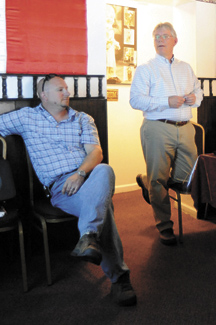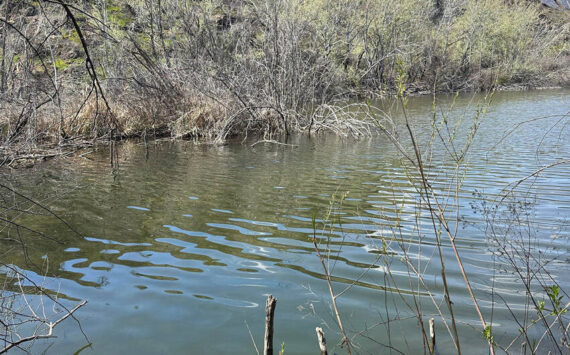
Dan Boettger, Director of Regulatory and Environmental Affairs for Okanogan County PUD and Glenn Huber, Area Manager for Oroville, were among the PUD representatives discussing the public electric utilities plans to license Enloe Dam at the Thursday, June
OROVILLE – Representatives from Okanogan County PUD made a presentation at the Oroville Chamber of Commerce on the utilities efforts to license Enloe Dam to once again generate hydroelectric power.
The dam and powerhouse, which are about 3.5 miles up the Similkameen River from Oroville, have not generated power since the mid-1950s. The PUD has been trying to license the dam with a new modern powerhouse and generators, this time located on the opposite bank of the river.
Dan Boettger, Director of Regulatory and Environmental Affairs for the utility, started the presentation with a slide show of then-and-now photos and illustrations. The photos showed the various stages of the dams construction as well as the different powerhouses that were located on the to generate power in the early years of operation. They also showed where new facilities would be located.
“The PUD’s new proposal has been in the works since 2005, as have our licensing efforts,” Boettger said. “The new plan would move the powerhouse to the parking lot area now there. The intake structure would have wide screening. One reason is that wider screes slow water and won’t cause fish to become impinged against the screen.”
Boettger explained the new location of the powerhouse is to meet requirements for fish because of the Endangered Species Act listing of steelhead and certain species of salmon. He said placing it where the old powerhouse is would not be favorable to water circulation and temperature at the exit. The new plan calls for water to exit at the falls.
“How’s the water temperature going to be affected?” asked Walt Hart, an Oroville City Council member.
“We hope it may actually improve, as well as the TDG, Total Dissolved Gasses and oxygen. Temperature is probably our biggest challenge. We’ve studied current temperatures above, below and at the dam. Our priorities are fish first… one way to ensure fish survival is to enhance oxygen levels.”
Another high priority is recreation, especially where other agencies and the public are concerned, according to Boettger. He said the PUD’s plan includes a park, a boat ramp, four camp sites, picnic areas, parking and a restroom.
The project will be run-of-the-river, generating the most electricity when the natural spring runoff occurs. At times that production may be reduced by low streamflows and Boettger said one or both the turbines can then be shut off.
When asked if the $31 million project made economic sense to ratepayers, Boettger said the purpose of the dam would be to ensure a more consistent source of electric power over the next 40 years and improve the delivery of power to Oroville. He said the Oroville area is currently served by one line coming from Tonasket. By having local generation available it would create a back up in case the Tonasket line went down, he said.
“How many years until the PUD recoups the investment?” asked Robin Stice.
“One of the things we have to do first is know what’s in the license,” said PUD Commissioner Ernie Bolz. “Then we will hire a firm to anticipate what we have to do beyond what we currently know. Enloe would guarantee a cost of power for the next forty years.”
Bolz went on to say that Enloe has the ability to be called a renewable resource even though it is hydroelectric power and that electric utilities are now required to include a percentage of their power from renewables.
“Electric prices are going up,” said Boettger. “Before we could go to Bonneville and say ‘hey we’re short.’ We can no longer do that. We’ve lost five megawatts of BPA power that was once available to us. It has now been reallocated across the system. We lost so others could gain.
“Even though this will be run-of-the-river, it will still provide a consistent source of power. Wind and solar when you need them most are typically not available. With Enloe we wouldn’t have to worry about the wind not blowing.”
The PUD filed for the license in 2008 and they are waiting for FERC, the Federal Energy Regulatory Commission to complete the process. They are also waiting on the state for a Water Quality Certification and a National Marine Fisheries study.





